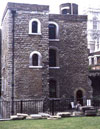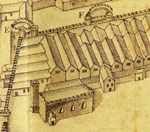Storage of the treasure
Several repositories for storing the king's treasure (crowns and other gold and silver jewels and plate), were in regular use in Richard's reign: at Westminster Abbey, in Westminster Palace and at the Tower of London. Other types of valuables had their own dedicated places of safekeeping. For example the Great Wardrobe was housed by the late fourteenth century in the London parish of St Andrew and the royal armoury was in the Tower.
Westminster Abbey

Plan of Westminster Palace and the east end of Westminster Abbey
Larger image (32KB)

The Pyx Chamber with storage chests, Westminster Abbey. After George Gilbert Scott, Gleanings from Westminster Abbey (Oxford, 1863)
One of the main places where treasure was stored during Richard II's reign was the so-called Great Treasury underneath the Chapter House on the east side of the cloister walk of Westminster Abbey. This treasury was in the charge of the treasurer and barons of the Exchequer. It was from here that valuables were taken to be used as pledges to the city of London to raise money for the French war early in Richard's reign and from here that they were delivered to Henry IV's keeper of the jewels in November 1399. The Chapter House crypt had served as a royal treasury by the 1260s. It was twice robbed in 1296 and in 1303, whereupon the treasure was removed for a time to the Tower. Soon after the second theft, the crypt was converted to make it more secure. Part of the cellar under the monks' dormitory was walled up to create the Pyx Chamber (sometimes known as the Pyx Chapel). Two skins of thick double doors were added over the existing door to safeguard the entrance. The wood of these doors has been dated by dendrochronology (the study of tree rings) to around 1300.
The Treasury of Receipt
When the king needed to pledge his valuables to raise money for his wars, or when valuables came into the crown's possession through forfeiture, they would pass in and out of the Treasury of the Exchequer on the north side of Westminster Hall. The Exchequer building still stands, although much rebuilt and restored. These transactions were accompanied by a mass of documents recording the movement of crowns or other valuables. Goldsmiths were brought in on occasion to make valuations and some picturesque details emerge of the baskets, chests and caskets in which items were stored.
The Jewel Tower

The Jewel Tower, Westminster
The Jewel Tower is now on an isolated site opposite the rebuilt Houses of Parliament. In the Middle Ages it stood well protected by a moat on three sides at the south-west corner of Westminster Palace. It was built in 1365-66 under Edward III. There is good evidence that the king's personal valuables were kept there. In 1402 the treasurer of Henry IV's chamber and keeper of his jewels obeyed royal orders transporting chosen pieces in and out of the Jewel Tower to the king for great feasts, wherever he was residing.
The Tower of London

The Flint Tower, Tower of London (marked F). After Survey of the Tower and its Liberties by Haiward and Gascoyne, 1597
Over the centuries different sites in the Tower of London were adapted to safeguard the king's valuables. Recent work by Jeremy Ashbee has given us our most coherent picture to date of this enigmatic subject. The treasure seems to have been moved about fairly regularly in an unplanned way from room to room as each became full and another became available. The White Tower at the centre of the Tower complex was under construction by the 1080s and was completed by the early 1100s. The palace on the two upper floors stood above store rooms in the basement. A room on the entrance floor may have concealed a Norman treasury. In the mid twelfth century a new palace was built along the river front; among its buildings was one named the treasure house. During the thirteenth century this palace was largely demolished. Henry III and Edward I greatly enlarged the Tower, but the places in the Tower where their valuables were kept remain obscure. After the robbery at Westminster Abbey in 1303, the Tower came back into prominence as a place of safekeeping. The place chosen to store treasure removed from Westminster seems to have been a small turret on the inner curtain wall now known as the Flint Tower. It is marked as F on the plan. This Tower would have been accessible by only one door opening from the castle bailey. On the other side the walls dropped down some thirty or forty feet.
By about 1320 the Treasury was occupying upper areas of the White Tower. Documents had been brought in containers from Westminster for sorting and placed in the Norman royal chapel of St John the Evangelist. They spilled over into adjoining rooms and sat alongside other chests storing miscellaneous valuables. Other containers of the same kind were placed in the locked rooms in the basement known as the Black Hall and the Black Chamber. Both these basement rooms can be pinpointed. They were both probably directly accessible from outside the White Tower and so dependent on their keys and locks for security.

The entrance to the inner chamber in the basement of the White Tower (Tower of London)
In 1327 Edward III's private treasure was placed in a more secure secret jewel chamber next to the Black Hall. This has been identified with an inner room two floors below St John's chapel. The walls are fifteen feet thick, there are no windows and there was only one door. Among treasures moved there in 1327 was 'La grande couronne du roi', probably the crown so named and valued at the enormous sum of £34,584 in the Richard II inventory. The royal crowns were almost certainly in the Pyx Chamber at Westminster Abbey by the time Richard's inventory was made. On the other hand, objects associated with the coronation ritual, also listed in the inventory, among them vestments, spurs and the sword CurtanaCurtana - or the Sword of Mercy, was one of the three swords carried before the monarch at the coronation , were still in the Tower in 1381 and may still have been there in 1399.
